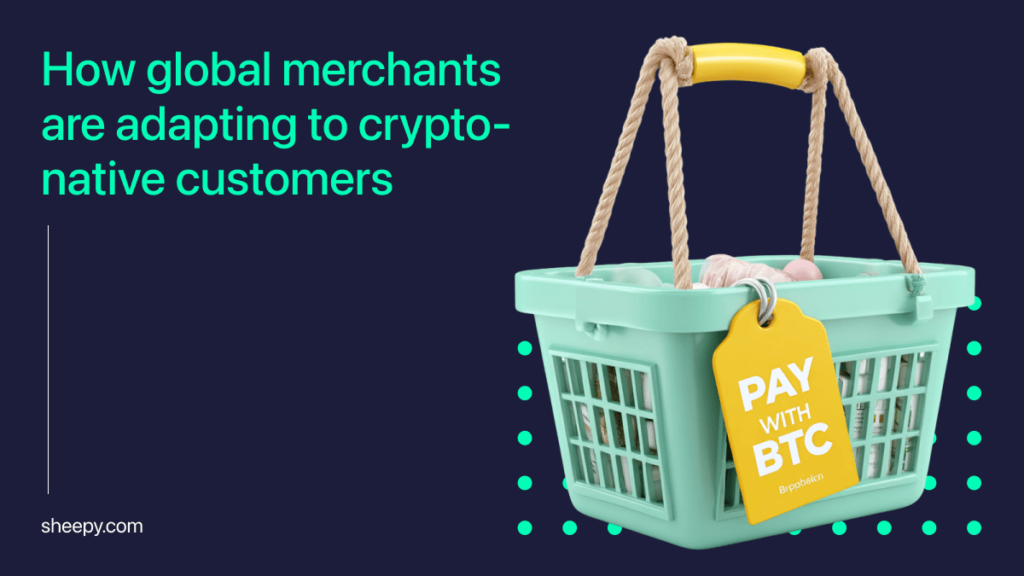How global merchants are adapting to crypto-native customers

The global payment landscape is undergoing a radical transformation. As more consumers become crypto-native – accustomed to using digital currencies as their primary financial tool – businesses around the world are under pressure to evolve. Traditional payment models no longer satisfy a growing segment of users who demand flexibility, privacy, and decentralization. To remain competitive and relevant, forward-thinking merchants are expanding their checkout options and embracing tools that support a wide spectrum of digital assets. In this new reality, the ability to seamlessly process 150+ cryptocurrencies isn’t just a technical perk – it’s a strategic necessity.
The rise of the crypto-native consumer
Over the past decade, a new kind of consumer has quietly reshaped the world of online commerce. These users don’t just invest in digital assets – they live by them. For many, cryptocurrencies are not an alternative method of payment. They are the default. This group is known as crypto-native consumers. They hold their money in digital wallets, transact directly through blockchain networks, and expect businesses to meet them where they already are.
Crypto-native customers tend to be younger, highly connected, and deeply familiar with digital systems. Many were early adopters of Bitcoin and have since moved into broader crypto ecosystems. Their preferences are shaped by decentralization, privacy, and a desire for greater control over their finances. Unlike traditional consumers, they don’t rely on credit cards or bank transfers. They want seamless, instant, and borderless payments. For them, slow settlement times or high conversion fees are not just inconvenient – they’re unacceptable.
Recent data shows that over 400 million people globally now own some form of cryptocurrency. Wallet usage is especially high in regions like Southeast Asia, Latin America, and parts of Africa. In the United States, surveys reveal that over 10% of adults have engaged in crypto transactions. As this user base grows, crypto adoption is no longer a niche trend. It’s a visible part of the digital economy.
Yet most legacy payment systems weren’t built with these consumers in mind. They rely on banks, intermediaries, and compliance layers that slow everything down. These systems are poorly suited to meet the demands of users who operate 24/7 across borders. For businesses, this disconnect is becoming a problem. Adapting to the pace of crypto adoption means rethinking payment infrastructure from the ground up.
Traditional rails are being challenged. The crypto adoption curve is rising fast. Merchants who understand the mindset of crypto-native users are beginning to realize that crypto adoption is not just about accepting coins. It’s about aligning with a new financial culture that is here to stay.
Shifting expectations: What modern users want
The habits of digital consumers are changing fast, especially among those who operate entirely in the crypto space. These users no longer tolerate delays or limits when making a payment. They want everything now, wherever they are, and they expect the same from businesses.
Speed, transparency, and round-the-clock access are not perks for them – they are the baseline. And as more users enter the market, businesses are finding that meeting these expectations is key to staying ahead in the race for relevance.
For crypto-native customers, privacy is more than a preference. It’s right. Many of them moved away from traditional banking because of surveillance, fees, and centralized control. They favor systems where they can hold, send, and receive money without asking for permission. This is one of the reasons why crypto adoption is rising in regions with unstable local currencies or where financial inclusion is limited. In these markets, digital wallets offer security and autonomy. The appeal of Bitcoin goes beyond speculation – it represents freedom and access.

Today’s users are also pushing for broader asset support. They want to pay with more than just the top cryptocurrency. They expect merchants to handle tokens across the entire crypto markets spectrum, including stablecoins and tokens built on fast networks. This shift is reshaping how payment systems are built. It’s not just about volume. It’s about meeting diverse needs with reliable tools. As the crypto adoption curve steepens, businesses across the United States and beyond are adjusting. Those who fail to keep up risk losing touch with a new generation of customers. And in this environment, crypto adoption is not optional – it’s essential for relevance.
Forward-thinking merchants already see it. They are listening to their users. And they know that embracing crypto adoption means more than adding a button at checkout. It’s about reimagining the whole experience from the ground up.
The new merchant mindset: From reluctant to ready
When cryptocurrencies first entered public discussion, most merchants treated them as a passing trend. Some were curious, but many were cautious. The idea of accepting digital tokens felt risky and unstable. Volatility, lack of regulation, and unfamiliarity with blockchain technology made it easier to stay with the old ways. But over time, hesitation began to shift. Real-world use cases, customer demand, and improved tools turned doubt into exploration – and now into action.
Industries like iGaming, E-commerce, and online services were among the first to notice the change. For these sectors, users are digital by default. They look for fast, flexible ways to pay. And when merchants began offering cryptocurrency options, the response was strong. Metrics showed reduced cart abandonment, wider geographic reach, and improved customer satisfaction. These weren’t just tech-savvy users – they were loyal customers who appreciated businesses willing to meet them halfway. As adoption crypto continues to rise, these early adopters now look less like outliers and more like leaders.
One important shift is how merchants now view risk. What once seemed like a gamble is becoming a growth strategy. Platforms are emerging that help with conversion, compliance, and automation. They remove complexity and allow merchants to focus on what they do best: serve their users. And while some are still on the sidelines, a growing number of companies in the United States and beyond are stepping in with confidence.
The trend is no longer theoretical. The data supports it. Global companies are embracing crypto adoption to remain competitive. As the crypto adoption curve continues to climb, it’s clear that change is not only coming – it’s already here. For merchants, adjusting now may be the key to thriving tomorrow in a world reshaped by crypto adoption.
Infrastructure matters: The role of gateways and processors
A strong payment experience begins with strong infrastructure. As more consumers rely on crypto in everyday transactions, the backend systems that power those payments have come into focus. Merchants aren’t just choosing whether to accept digital currencies – they’re deciding how to support them. This is where gateways and processors make all the difference. They determine whether payments are fast, secure, and simple – or frustrating and full of risk.
Speed and automation now sit at the core of what modern users expect. But businesses also need tools they can trust.
APIs that simplify wallet interactions, systems that manage volatility, and services that automate settlements are now essential. Companies want to focus on growth, not on patching together technical workarounds every time a new asset gains traction.
In a landscape that shifts rapidly, flexibility is key. Many platforms now emphasize broad asset coverage, with some claiming support for 150+ cryptocurrencies to meet global demand. While volume alone doesn’t guarantee quality, it reflects the growing expectation from users to pay with whatever they hold – be it a stablecoin, a layer-2 token, or something more niche.
This is where Sheepy crypto payment gateway enters the conversation. It offers businesses a simple way to start accepting digital assets without building complex systems internally. It’s a quiet, powerful shift in how companies approach payments – not as an experiment, but as a standard.
As crypto adoption becomes a force in mainstream commerce, infrastructure will decide who leads. Those prepared to adapt, streamline, and integrate will stand out. And in a market shaped by constant change, the ability to evolve with crypto adoption may be the most valuable tool of all.
Future-proofing commerce with crypto
The digital economy doesn’t stand still. Every few years, new technologies rewrite the rules of how businesses operate. For merchants, keeping up with change is no longer about being first – it’s about staying relevant. Crypto is no longer a trend. It’s a shift in how people think about money, and that shift is shaping the future of commerce in real time.

The next phase of growth will depend on how well businesses adapt to the infrastructure already being built. Token diversity gives companies a way to scale across regions and demographics. Whether someone is paying in a stablecoin or a region-specific digital asset, merchants who are flexible will win trust and loyalty. Instead of limiting payments to familiar options, future-ready platforms offer a wider net – one that catches users wherever they are.
Regulation is also changing. In more countries, rules around crypto payments are becoming clearer. This creates a stable path forward for companies that once waited on the sidelines. What was once considered a legal gray area is now being recognized as part of legitimate commerce. And with better policy comes more confidence – for both businesses and their customers.
What sets leaders apart today is not just adoption but commitment. Embracing crypto adoption isn’t about ticking a box. It’s about designing operations that are ready for tomorrow. As more users expect this level of readiness, businesses that move now will be in the best position to lead. In this landscape, crypto adoption is not the end goal – it’s the foundation. Those who treat it that way will stay ahead of the curve. Because in the new economy, crypto adoption means long-term relevance.
A new standard takes hold
Digital payments are no longer evolving on the margins – they are reshaping the core of how commerce works. What once felt experimental is becoming expected. The merchants who succeed in this shift are those who listen, adapt, and build with intention. This isn’t about chasing trends. It’s about recognizing permanent change and responding with clarity. As the tools mature and users grow more fluent in digital finance, businesses that stay still risk being left behind. Embracing crypto adoption is part of that readiness. Those who move forward now won’t just survive the change – they’ll help define what comes next.






